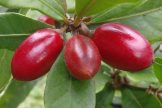
Kunzea pomifera
Absolutely fabulous native fruit, rapidly gaining favour not just with local provedores but also by our top chefs and leading restaurateurs. Containing up to four times the level of antioxidants of blueberries, these little berries are about to take off.
Some known Aboriginal names:
Munta, ngerp, nurp, nurt (Boanditj), Mantirri (Kaurna)
Manter (Ngaiawang), Mantari (Ramindjeri), Mantar (Jaril)
Common names Munterberry, Muntries, Munthries, Emu Apples, Native Cranberries
Kunzea pomifera is a woody ground cover occurring in the wild in western Victoria and SA. It was an important food plant for the local Aboriginal people. They dried or baked surplus fruit into cakes to eat during the winter months. They also traded the fruit for important tools with neighbouring tribes. The plants produce fluffy white flowers in spring, followed by berries in Feb-March. They should start producing berries three years after planting. Berries may remain green but still be ripe. If left too long, the berries become unpalatable.
Cultivation
K.pomifera can be grown either in dappled shade or in full sun. It makes a useful weed suppressing ground cover of around 1.5m. The farmers that cultivate K.pomifera have successfully trellised the plant so that the berries are more easily accessible for picking. The plant can be used to stabilise sandy soils. It requires a neutral pH and will withstand some soil salinity.
An important thing to note is that K.pomifera does not like root disturbance of any kind. This includes weeding around the plant, so mulch well from the beginning. K.pomifera is insect pollinated. Planting other spring flowering plants nearby will help to attract the necessary insects. In the wild, the plant survives on 500-800mm of water a year. This is approximately Melbourne’s annual rainfall, so the plants should not need too much extra water. It will however do better if watered in long dry spells. There is some anecdotal evidence to suggest that too much water reduces the intensity of the flavour of the berries.
A green to red berry with purplish tinge, up to 1cm in diameter with a flavour of apple cinnamon, or a granny smith apple flavour with a sweet sultana finish and a hint of spice.
Muntries can be used in a range of ways from marmalades to chutneys, preserves, syrups, juices, beverages, sauces, muffins, fruit leathers, jellies, specialty breads and added fresh to salads.
• Fruit can be stored at low temperature (freezer < -18ºC) for up to 24 months.
• Fresh fruit can be stored for up to two weeks in the refrigerator at 5°C.
• Fruit that has been frozen should be washed prior to use.
Naturally growing as a ground cover, you can grow Muntries on a trellis very successfully. They prefer a pH of between 6 to 8 and not too much water. Altogether an easy plant to grow.
Uses in the Kitchen
The Australian Native Food Industry Food Limited describes the fruit as tasting like “apple with a juniper essence, a spicy apple taste”. While the Australian native flavour wheel describes the taste as having the “Aroma of moist fruit mince, spice, bush honey and butter.” The berries are crunchy when eaten raw.
Early settlers used the fruit in pies. Today, they are usually enjoyed in jams, chutney, relishes, sauces and conserves.





